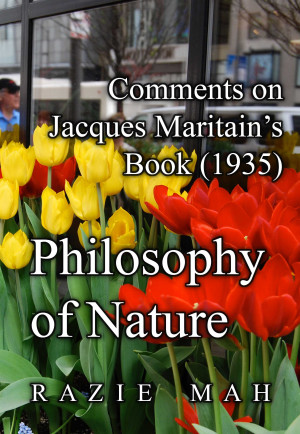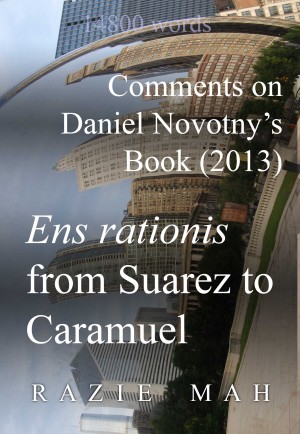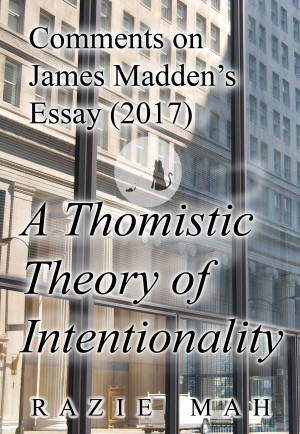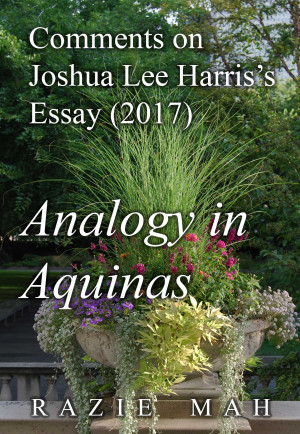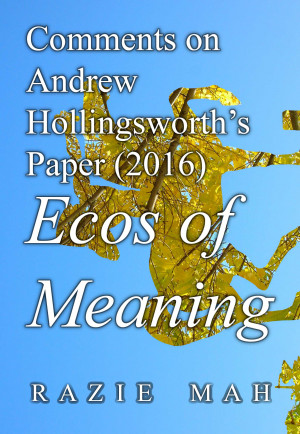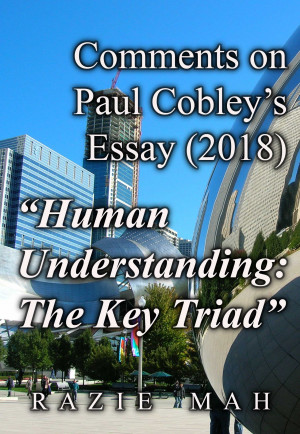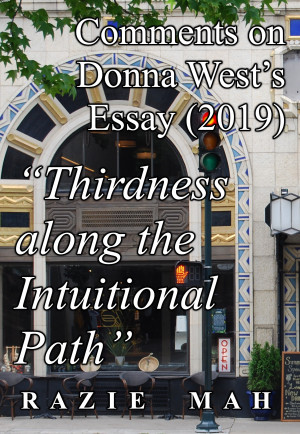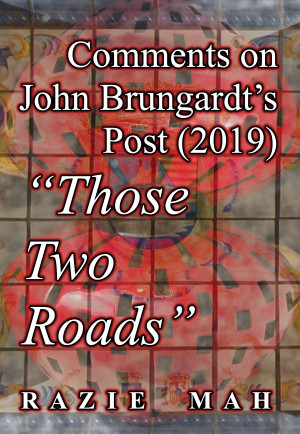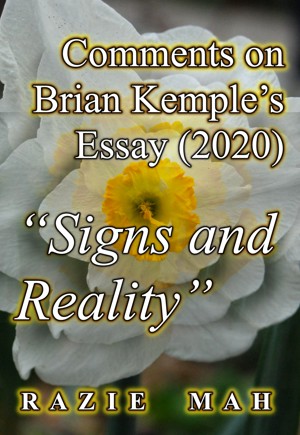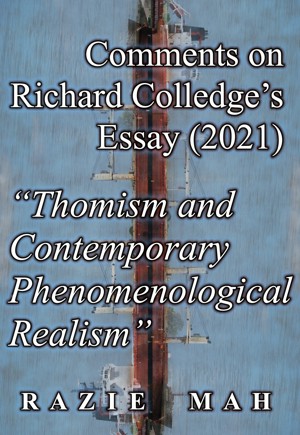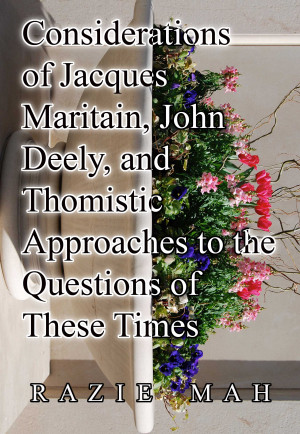
By Razie Mah
Two models are used to appreciate now-forgotten paths stretching from Baroque scholastics to the present day. These models are the triadic structure of judgment and the category-based nested form. Two recent intellects stand out. One is Jacques Maritain. Born in France, he comes to North America around the time of the second world war. He is keenly interested in how to recover a scholastic approach within this world of modern science. Another is John Deely, whose recent death marks the end of a long career as both a Thomist and a semiotician. Deely confronts the philosophers of the day in a very entertaining manner. This series contains comments on articles from journals such as the American Catholic Philosophical Association, Faith and Philosophy, as well as books, including Daniel Novotny's excellent works on the Baroque scholastics. This series is not a course. It is a place to sample ideas. I encourage readers to consider both the original and the comments. They may be read in tandem or in sequence.
Considerations of Jacques Maritain, John Deely and Thomistic Approaches to the Questions of These Times
Comments on Jacques Maritain's Book (1935) Philosophy of Nature
by Razie Mah
Series: Considerations of Jacques Maritain, John Deely and Thomistic Approaches to the Questions of These Times · Empirio-schematics.
Price:
$2.99 USD.
Words: 19,310.
Language:
English.
Published: July 1, 2018
.
Categories:
Nonfiction » Science & Nature » Philosophy of Science, Nonfiction » Religion & Spirituality » Religion & Science
Jacques Maritain, bless his soul, strove to recover a scholastic philosophy of nature at the apex of modernism. How is a philosophy of nature related to science, on the one hand, and metaphysics, on the other? These comments re-articulate and explore Maritain's work using a model of judgment as a triadic relation, plus the category-based nested form.
Comments on Nicholas Berdyaev's Book (1939) Spirit and Reality
by Razie Mah
Series: Empirio-schematics · Considerations of Jacques Maritain, John Deely and Thomistic Approaches to the Questions of These Times.
Price:
$2.50 USD.
Words: 11,320.
Language:
English.
Published: December 30, 2018
.
Categories:
Nonfiction » Science & Nature » Philosophy of Science, Nonfiction » Religion & Spirituality » Religious philosophy
What is Spirit? What is Reality? Nicholas Berdyaev, a contemporary of Jacques Maritain, takes Positivist and empirio-schematic judgments in surprising directions. These comments rely on diagrams of these triadic structures developed in Comments on Jacques Maritain's Book (1935) Natural Philosophy.
Comments on John Deely's Book (1994) New Beginnings
by Razie Mah
Series: A Course on Implicit and Explicit Abstraction · Considerations of Jacques Maritain, John Deely and Thomistic Approaches to the Questions of These Times · Peirce's Secondness and Aristotle's Hylomorphism.
Price:
$2.99 USD.
Words: 9,930.
Language:
English.
Published: July 16, 2016
.
Categories:
Nonfiction » Philosophy » Methodology, Nonfiction » Education & Study Guides » Home schooling
This 9,900 word essay comments on John Deely’s analysis of scholasticism of the Baroque Era. The category-based nested form is used to model arguments about the causality inherent in triadic signs. In particular, Suarez’s interscope for ens rationis applies.
Comments on Daniel Novotny’s Book (2013) Ens Rationis from Suarez to Caramuel
by Razie Mah
Series: A Course on Implicit and Explicit Abstraction · Considerations of Jacques Maritain, John Deely and Thomistic Approaches to the Questions of These Times.
Price:
$2.99 USD.
Words: 14,800.
Language:
English.
Published: April 23, 2016
.
Categories:
Nonfiction » Philosophy » Religious philosophy, Nonfiction » Education & Study Guides » Home schooling
This 14,800 word essay comments on Daniel Novotny’s study in scholasticism of the Baroque Era. The category-based nested form is used to model arguments about beings of reason (by Suarez, Hurtado, Mastri, Belluto and Caramuel). Implicit and explicit abstraction are modeled along the way.
Comments on Daniel Novotny’s Essay (2017) Izquierdo on Universals
by Razie Mah
Series: Considerations of Jacques Maritain, John Deely and Thomistic Approaches to the Questions of These Times.
Price:
$1.60 USD.
Words: 3,700.
Language:
English.
Published: May 20, 2017
.
Categories:
Nonfiction » Religion & Spirituality » Christian Theology / Anthropology, Nonfiction » Religion & Spirituality » Psychology of Religion
Disputation 17 of the Baroque scholastic treatise The Lighthouse of the Sciences (1659) covers the topic of universals. Sebastian Izquierdo wrote the treatise. Daniel Novotny published a summary in the Spring 2017 issue of the American Catholic Philosophical Quarterly. My comments demonstrate the postmodern relevance of this topic, using the category-based nested form.
Comments on James Madden’s Essay (2017) A Thomistic Theory of Intentionality
by Razie Mah
Series: Considerations of Jacques Maritain, John Deely and Thomistic Approaches to the Questions of These Times.
Price:
$1.70 USD.
Words: 4,680.
Language:
English.
Published: April 8, 2017
.
Categories:
Nonfiction » Religion & Spirituality » Christian Theology / Anthropology, Nonfiction » Philosophy » Metaphysics
This work comments on an essay by James D. Madden published in the Winter 2017 edition of The American Catholic Quarterly. The essay is titled, “Is a Thomistic Theory of Intentionality Consistent with Physicalism?” My goal is to re-articulate the argument in the specialized language of the category-based nested form.
Comments on Joshua Lee Harris’s Essay (2017) Analogy in Aquinas
by Razie Mah
Series: Considerations of Jacques Maritain, John Deely and Thomistic Approaches to the Questions of These Times.
Price:
$1.60 USD.
Words: 4,810.
Language:
English.
Published: April 29, 2017
.
Categories:
Nonfiction » Religion & Spirituality » Christian Theology / General, Nonfiction » Philosophy » Religious philosophy
This work comments on an essay published by Joshua Lee Harris in the January 2017 edition of Faith and Philosophy: Journal of the Society of Christian Philosophers (volume 34(1), pages 33-56), under the title, “Analogy in Aquinas: The Alston-Wolterstorff Debate Revisited”. My goal is to re-articulate Harris’s work in the specialized language of the category-based nested form.
Comments on Roger Teichmann’s Article (2016) The Identity of a Word
by Razie Mah
Series: Considerations of Jacques Maritain, John Deely and Thomistic Approaches to the Questions of These Times.
Price:
$1.25 USD.
Words: 3,010.
Language:
English.
Published: March 20, 2016
.
Categories:
Nonfiction » Philosophy » Language, Nonfiction » Education & Study Guides » Essays
This 3100 word essay comments on an article appearing in the winter 2016 issue of The American Catholic Philosophical Quarterly (Volume 90). The article is titled, The Identity of a Word. The author of the article is Roger Teichmann, a professor at St. Hilda’s College, University of Oxford in Oxford, United Kingdom.
Comments on Andrew Hollingsworth’s Paper (2016) Ecos of Meaning
by Razie Mah
Series: Considerations of Jacques Maritain, John Deely and Thomistic Approaches to the Questions of These Times.
Price:
$1.50 USD.
Words: 4,400.
Language:
English.
Published: February 18, 2017
.
Categories:
Nonfiction » Religion & Spirituality » Biblical Studies / Exegesis & Hermeneutics, Nonfiction » Philosophy » Language
This essay comments on Andrew Hollingworth’s presentation at the annual meeting of the Evangelical Theological Society (2016) in San Antonio. His paper is subtitled Umberto Eco’s Semiotic Theory for Theological Hermeneutics. The category-based nested form is used to model features of Umberto Eco’s semiotic theory. These models are applied to an example.
Comments on Paul Cobley's Essay (2018) "Human Understanding: A Key Triad"
by Razie Mah
Series: Considerations of Jacques Maritain, John Deely and Thomistic Approaches to the Questions of These Times · Peirce's Secondness and Aristotle's Hylomorphism.
Price:
$2.00 USD.
Words: 3,600.
Language:
English.
Published: August 5, 2018
.
Categories:
Nonfiction » Philosophy » Epistemology, Nonfiction » Literary criticism » Semiotics & Theory
Paul Cobley, at Middlsex University, composes a remembrance for John Deely, by reviewing one of many innovative notions. These comments re-articulate this article using the category-based nested form. Deely's triad consists of actualities in an interscope.
Comments on Matthew Minerd’s Essay (2019) "Thomism and the Formal Object of Logic"
by Razie Mah
Series: Considerations of Jacques Maritain, John Deely and Thomistic Approaches to the Questions of These Times · Peirce's Secondness and Aristotle's Hylomorphism.
Price:
$2.14 USD.
Words: 6,430.
Language:
English.
Published: June 22, 2019
.
Categories:
Nonfiction » Philosophy » Logic, Nonfiction » Philosophy » Metaphysics
In 2019, Matthew Minerd publishes a narrative in the American Catholic Philosophical Quarterly. The story concerns the historical development of the science of logic within the Thomist school. These comments use the category-based nested form and other relational models developed within the tradition of C.S. Peirce.
Comments on Donna West’s Essay (2019) "Thirdness along the Intuitional Path"
by Razie Mah
Series: Considerations of Jacques Maritain, John Deely and Thomistic Approaches to the Questions of These Times · Peirce's Secondness and Aristotle's Hylomorphism.
Price:
$1.95 USD.
Words: 5,070.
Language:
English.
Published: November 2, 2019
.
Categories:
Nonfiction » Philosophy » Logic, Nonfiction » Philosophy » Metaphysics
In 2019, Donna West publishes an inquiry in Studia Gilsoniana. The complete title is “Thirdness along the Intuitional Path: Reflections from Maritain and Peirce”. The essay addresses a key question: What are the pre-conditions for the emergence of event relations? These comments diagram features using the category-based nested form and the triadic structure of judgment.
Comments on Fr. Thomas White’s Essay (2019) "Thomism for the New Evangelization"
by Razie Mah
Series: Considerations of Jacques Maritain, John Deely and Thomistic Approaches to the Questions of These Times.
Price:
$2.00 USD.
Words: 5,900.
Language:
English.
Published: November 9, 2019
.
Categories:
Nonfiction » Religion & Spirituality » Religious philosophy, Nonfiction » Philosophy » Metaphysics
Why does Thomism matter? In 2019, Fr. Thomas Joseph White, O.P., offers his insights on the promise of Thomism for the new evangelization. His argument touches on six key points. These comments show how Peirce’s categories and semiotics bring these key points, as well as the promise of Thomism, forward, in novel ways. Welcome to the Age of Triadic Relations.
Comments on John Brungardt’s Post (2019) "Those Two Roads"
by Razie Mah
Series: Considerations of Jacques Maritain, John Deely and Thomistic Approaches to the Questions of These Times · Peirce's Secondness and Aristotle's Hylomorphism.
Price:
$1.75 USD.
Words: 3,330.
Language:
English.
Published: May 23, 2020
.
Categories:
Nonfiction » Philosophy » Metaphysics, Nonfiction » Philosophy » Aesthetics
Thomistica is a website, sponsored by the Sacra Doctrina Project, containing substantial scholarly posts. In 2019, John G. Brungardt posts a proposal concerning difficulties arising from Aristotle’s definition of motion and how they may serve theology. My comments speculatively recast his argument using Peirce’s secondness and the category-based nested form.
Comments on Brian Kemple’s Essay (2020) "Signs and Reality"
by Razie Mah
Series: Considerations of Jacques Maritain, John Deely and Thomistic Approaches to the Questions of These Times · A Course on Evolution and Thomism.
Price:
$2.25 USD.
Words: 4,020.
Language:
English.
Published: July 24, 2021
.
Categories:
Nonfiction » Philosophy » Metaphysics, Nonfiction » Religion & Spirituality » Christian Theology / Anthropology
In 2020, Brian Kemple publishes an article in Reality: A Journal for Philosophical Discourse. The point is simple. Triadic relations, such as signs, are things. They are real, even though they appear to be contingent upon um... things. Maybe the point is not so simple. These comments use the category-based nested form and other relational models developed within the tradition of C.S. Peirce.
A Reverie on Mark Spencer’s Essay (2021) "The Many Phenomenological Reductions"
by Razie Mah
Series: Considerations of Jacques Maritain, John Deely and Thomistic Approaches to the Questions of These Times · Phenomenology and the Positivist Intellect.
Price:
$1.82 USD.
Words: 5,100.
Language:
English.
Published: September 4, 2021
.
Categories:
Nonfiction » Philosophy » Movements / Phenomenology, Nonfiction » Philosophy » Metaphysics
In 2021, Mark Spencer publishes an essay in the American Catholic Philosophical Quarterly, concerning phenomenology and metaphysics. Do both engage modern science? Are reductions in phenomenology similar to anti-reductions in metaphysics? Should they speak to one another? These comments use the category-based nested form and other relational models developed within the tradition of C.S. Peirce.
Comments on Joseph Trabbic’s Essay (2021) "Jean-Luc Marion and ... First Philosophy"
by Razie Mah
Series: Considerations of Jacques Maritain, John Deely and Thomistic Approaches to the Questions of These Times · Phenomenology and the Positivist Intellect.
Price:
$1.82 USD.
Words: 5,770.
Language:
English.
Published: September 18, 2021
.
Categories:
Nonfiction » Philosophy » Movements / Phenomenology, Nonfiction » Philosophy » Metaphysics
In 2021, Joseph Trabbic publishes an inquiry in the American Catholic Philosophical Quarterly. He asks, "What is Jean-Luc Marion talking about?" The missing portion of the title is in French and translates as "The Phenomenology of the Gift". Or perhaps, "Givenness". These comments use the category-based nested form and other relational models developed within the tradition of C.S. Peirce.
Comments on Richard Colledge’s Essay (2021) "Thomism and Contemporary Phenomenological Realism"
by Razie Mah
Series: Considerations of Jacques Maritain, John Deely and Thomistic Approaches to the Questions of These Times · Phenomenology and the Positivist Intellect.
Price:
$2.15 USD.
Words: 7,530.
Language:
English.
Published: September 25, 2021
.
Categories:
Nonfiction » Philosophy » Movements / Phenomenology, Nonfiction » Philosophy » Metaphysics
In 2021, Richard Colledge publishes an article in the American Catholic Philosophical Quarterly exploring the possibility of a renewed engagement. Can these two traditions profitably interact? Or does the interaction produce a revealing intellectual twist? These comments use the category-based nested form and other relational models developed within the tradition of C. S. Peirce.

